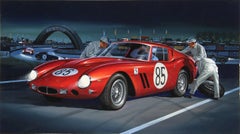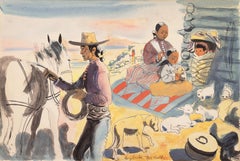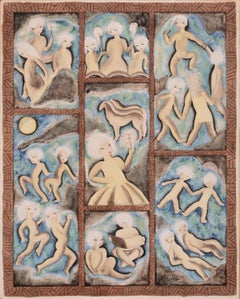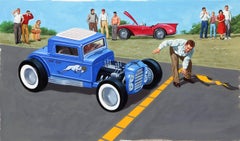Jack Leynnwood Art
to
1
Overall Width
to
Overall Height
to
1
1
1
1
1
1
1
1
1
1
1
1
1
1
1
9,980
2,753
1,376
1,373
1
Artist: Jack Leynnwood
Ferrari Berlinetta 563, circa 1964, Gouache Illustration by Jack Leynnwood
By Jack Leynnwood
Located in Long Island City, NY
This gouache painting on illustration board was created by American artist Jack Leynnwood. Fascinated by aviation from a young age, Leynnwood did kit illustrations of everything from military aircraft to rigged ships, Rat Finks, Flash Gordon, space ships and Ed “Big Daddy...
Category
1960s Photorealist Jack Leynnwood Art
Materials
Gouache, Illustration Board
Related Items
'Navajo Family', Santa Fe, Modernism, Corcoran, Whitney, PAFA, AIC, WPA
By Eduard Buk Ulreich
Located in Santa Cruz, CA
Signed lower center, 'by Buk' for Eduard Buk Ulreich (American, 1889-1966), dedicated lower center, 'for Ruth' and painted circa 1945. Additionally signed and titled verso 'Navajo Fa...
Category
1940s Art Deco Jack Leynnwood Art
Materials
Watercolor, Gouache, Illustration Board
'Childhood', Paris, Salon d'Automne, New York, ASL, Corcoran, PAFA, Art Deco
By Nura Ulreich
Located in Santa Cruz, CA
Signed lower right 'Nura' for Nura Woodson Ulreich (American, 1899–1950). Titled, verso, 'Childhood', signed with artist's Paris address and dated 1926.
This early twentieth-century...
Category
1920s Surrealist Jack Leynnwood Art
Materials
Watercolor, Gouache, Illustration Board
$3,600
H 16 in W 12 in D 0.13 in
'Age 9', Art Deco, Woman Artist, AIC, ASL, Paris, Salon d'Automne, Corcoran
By Nura Ulreich
Located in Santa Cruz, CA
Painted by Nura Woodson Ulreich (American, 1899-1950) as a full-page illustration for the book 'The Buttermilk Tree', unsigned and dated circa 1935. A rare example of a fully-develop...
Category
1930s Jack Leynnwood Art
Materials
Gouache, Illustration Board, Pen, Pencil
$5,500
H 11.25 in W 9.25 in
Church Interior
By Ray Quigley
Located in Buffalo, NY
A modern illustration by American artist Ray Quigley depicting two men inside of a church.
Category
1950s Realist Jack Leynnwood Art
Materials
Gouache, Illustration Board, Ink
Threesome - Swingers - 1970s cocktail party - Playboy Cartoon
By Dink Siegel
Located in Miami, FL
If anyone has ever put pen to paper and tried to draw a face or a figure with any level of success, then you know how hard it is to do. Cartoonists are first conceptual artists for ...
Category
1970s American Modern Jack Leynnwood Art
Materials
Ink, Gouache, Illustration Board
$12,000
H 11.5 in W 9 in
WWII Anti-Nazi Poster - Jimmy Stewart's Sister
Located in Miami, FL
It's the beginning of WWII, and the Nazi war machine is on the move. For an anti-Nazi poster competition, female illustrator Mary Stewart chooses a very yo...
Category
1940s American Realist Jack Leynnwood Art
Materials
Charcoal, Gouache, Illustration Board
'The Thief from François Villon's Christmas', San Francisco Bay Area Illustrator
By James March Phillips
Located in Santa Cruz, CA
Signed lower right, 'James March Phillips' (American, 1913-1981) and painted circa 1965.
Displayed in an original card mat decorated by the artist. Signed lower right, in pencil, 'J....
Category
1960s Jack Leynnwood Art
Materials
Gouache, Illustration Board
"San Anton Palace Malta" Early 20th Cent. Garden and Fountain Watercolor Russian
Located in Soquel, CA
A significant early 20th century landscape watercolor of the paradisical gardens at San Anton Palace in Attard, Malta by Nicholas Krasnoff, 1920 (Russian, 1864-1939). This beautiful piece is a wonderful example of the renowned Russian architect's prized watercolors, created while he was exiled to Malta in the early 1920's. Depicting a lush garden full of blooming, colorful flowers and a stately fountain at the San Anton Palace in Malta, one can see the deft hand and attention to detail rendered by the proficient artist and architect's hand.
Signed "N. Krasnoff" lower right. Titled and dated "Malta, St. Antonio 1920".
Unframed.
Measures 10.25"H x 14.25"W.
Right corner has a crease from being bent.
Nikolay Petrovich Krasnov, also known as Nicholas Krasnoff or Peter Nicholas Krasnoff, was a Russian Serbian architect and painter. He served as Chief Architect of Yalta, Crimea (1887-1899). From 1922 he lived and worked in the Kingdom of Yugoslavia, and was a key figure in the architectural development of Belgrade. Attending the Moscow School of Painting, Sculpture and Architecture in 1876, aged 12. As a young artist he received patronage from Sergey Tretyakov, brother of the founder of Moscow's Tretyakov Gallery, and entrepreneur Petar Gubonyin.
In 1887 Krasnov became Chief Architect in Yalta. At the age of 23, Krasnov had large responsibility for the rapid growth of the city. He expanded the promenade, which by 1913 became the city's main street, before creating a new city plan in 1889 (including a new sewer system, planning regulations, new streets, prevention of unregulated construction, a school and children's hospital, and the construction of the Pushkin Boulevard). Two concrete bridges were built over the river, and the embankment strengthened. Krasnov also ran a private practice in Yalta until 1911. Among his most famous work is the Livadia Palace, later the location of the 1945 Yalta Conference. Designed over 60 buildings in Crimea, blending a modernist style with local traditions. Also of note: Dulber Palace, Koreiz (1895-97), Alexander Nevsky Cathedral, Yalta (1902), Yusupov Palace, Koreiz (1909), Kokkoz Jami Mosque, Sokolyne (1910).
In 1913, he presented a collection of illustrations he had produced of his works to the Saint Petersburg Academy of Arts, where he held the title of academician. An opponent of the Russian Revolution, he left Yalta with his family in 1919 for Malta, alongside the Dowager Empress Marie Feodorovna, sister of Queen Alexandra, and over 600 members of the Russian aristocracy. Nikolay was in a group housed in the empty Villa St Ignatius, which had been a Jesuit college and then a hospital during World War I. To earn money, Nikolay painted many scenes of Malta, signing his paintings as N. Krasnoff. He is known as Nicholas Krasnoff in Malta. In May 2016 MaltaPost issued a commemorative set of stamps in his honor.
In 1922 Krasnov moved to Belgrade, then part of the Kingdom of Yugoslavia, where he became head of the Department of Monumental Architectural Developments and Monuments. His building designs in Serbia number around 60, and were created under the name Nikola Krasnov, as a mark of respect to his adopted homeland.
His key works in Belgrade include: Ministry of Forestry building (now Ministry of Foreign Affairs) (1923) which bears a memorial plaque...
Category
1920s Impressionist Jack Leynnwood Art
Materials
Paper, Watercolor, Illustration Board
$12,400 Sale Price
20% Off
H 10.25 in W 14.25 in D 0.13 in
Reading Before Bed, Original Illustration, Mother, Daughter, Cat, Book Worm
Located in Grand Rapids, MI
Robert Konersman (American, 1889 - 1975)
Signed: Konersman (Lower, Left)
" Reading Before Bed " c. 1900-1920
Watercolor and Gouache on Paper Laid on Illustration Board
Image Size...
Category
Early 20th Century Realist Jack Leynnwood Art
Materials
Paper, Watercolor, Gouache, Illustration Board
Vintage Bi-Plane Watercolor
Located in San Francisco, CA
Vintage bi-plane
Category
20th Century Jack Leynnwood Art
Materials
Watercolor, Illustration Board
Cherry Dancer
By Marcel Vertès
Located in Miami, FL
Cherry Dancer
Marcel Vertes
French, 1895-1961
Beautiful girl juggling cherries
Work is round but is shown in a square frame and some of the artworks edge is exposed
Description: ...
Category
1930s Post-Impressionist Jack Leynnwood Art
Materials
Gouache, Illustration Board
"The Sphynx is Weary, She Dreams o'er the World" John La Farge, American Artist
By John La Farge
Located in New York, NY
John La Farge
The Sphynx is Weary, She Dreams o'er the World, 1865
Initialed and dated lower right
Gouache, watercolor and black chalk on illustration board
10 1/4 x 12 3/8 inches
P...
Category
1860s Symbolist Jack Leynnwood Art
Materials
Chalk, Watercolor, Gouache, Illustration Board
$12,000
H 14.25 in W 16.5 in
Previously Available Items
Ramrod 509, Vintage Car Illustration
By Jack Leynnwood
Located in Long Island City, NY
Artist: Jack Leynnwood, American (1921 - 1999)
Title: Ramrod 509
Medium: Gouache on Illustration Board
Image Size: 8 x 14 inches
Size: 15 x 20 in. (38.1 x 50.8 cm)
Category
1960s American Realist Jack Leynnwood Art
Materials
Gouache, Illustration Board
Jack Leynnwood art for sale on 1stDibs.
Find a wide variety of authentic Jack Leynnwood art available for sale on 1stDibs. You can also browse by medium to find art by Jack Leynnwood in board, gouache, illustration board and more. Much of the original work by this artist or collective was created during the 1960s and is mostly associated with the Photorealist style. Not every interior allows for large Jack Leynnwood art, so small editions measuring 24 inches across are available. Customers who are interested in this artist might also find the work of Alicia Czechowski, Brian Cobble, and Tricia Butski. Jack Leynnwood art prices can differ depending upon medium, time period and other attributes. On 1stDibs, the price for these items starts at $6,800 and tops out at $6,800, while the average work can sell for $6,800.



